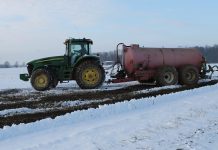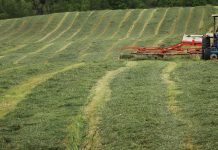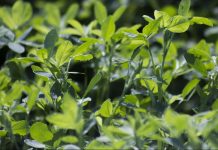Making high quality dairy forage can be difficult, especially between forecasted rains. “Hay in day,” or more accurately high moisture haylage in a day, is increasing in popularity to optimize forage nutrition and to increase the number of hay making days during the year.
The goal of hay in a day is to mow, rake, chop (or bale and wrap) forages all in one day. It sounds difficult, but it may be a good option for your farm. Like any hay-making process, the goal of making haylage in a day is to get forages to the correct moisture suitable for chopping or baleage as quickly as possible.
The cornerstone to get forages to 60% moisture in one day is the use of wide swaths during mowing. Wide swaths lay hay out as wide as possible, and at least 70% of the mower width. Research has shown that wide swathing alfalfa increases forage quality, primarily through maintaining forage quality with rapid dry down.
Unlike dry hay, making haylage in one day is less reliant on conditioning. Immediately after cutting forages, moisture is largely lost through the stomata in the leaves via the plants internal water transport pathways.
Crushing the stems with conditioning rolls or impellers disrupts this natural process by destroying the “plumbing pipes” inside the plant. Wide swaths without conditioning will dry faster during this initial drying period and is typically sufficient to obtain proper moisture for haylage within eight hours.
Shortening the time from mowing to making haylage in a day preserves nutrients. Forages contain the maximum potential nutrition value at mowing, no matter the growth stage. As a dairy farmer, you want all of that nutrition to make it to the cows, but it’s a race against the clock to capture it all.
Every step of the hay-making process can negatively affect the quality of the forage, and your goal is to minimize the loss of nutrients. After cutting, plants will continue to respire using up stored sugars until they are dry (20% or less), or fermented in baleage. Once baleage is wrapped, this continued respiration promotes the fermentation process.
Hay in a day practices using wide swaths have been shown to have higher feed value compared to narrow swaths. Lower neutral detergent fiber and higher non-carbohydrate fiber have been reported compared to the traditional narrow swath hay. Wider swaths likely will require the tractor to drive over the already mowed crop. Despite this, there has been no ash (dirt) content difference found between wide or narrow swath widths.
Without the need for conditioning, a cost savings could be realized when purchasing equipment. Disc mowers without conditioning rolls can be half the cost of mower conditioners, can be operated with lower horsepower tractors and can have can have mowing widths over 20 feet.
Hay in a day will not work for everyone. Obviously, this approach does not work when trying to make dry hay (20% or less), but weather conditions, forage species and ground conditions can influence the success of this approach.
Cloudy days with limited sunlight will delay the initial drying process making it difficult to obtain proper moisture in one day. Heavy stands of forage will also have difficulty reaching proper moisture without additional tedding passes.
If you’re looking for a way to keep your forage harvests on schedule and take advantage of short weather windows, maybe hay in a day will work for you.













